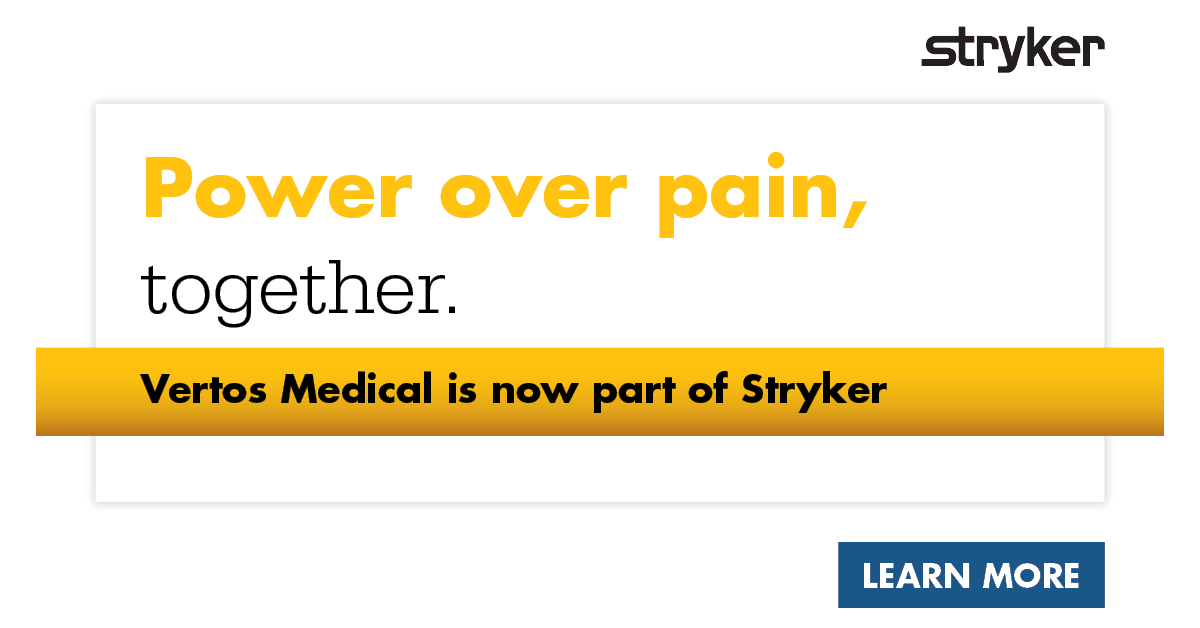Challenge Your Thinking Around ESIs—Change Your Practice
Author— Peter Pryzbylkowski, MD Published April 13, 2021
When I started offering the mild® Procedure, I wanted to see the patient outcomes for myself; and when I did, I knew it had a place in my practice. The questions then became, “How do I routinely offer this in my practice, and where does it fit in with my lumbar spinal stenosis (LSS) patient care path?” Epidural steroid injections (ESIs) have historically served as the standard of care (and an easy, early intervention) for lumbar spinal stenosis patients. But now we have mild®—a proven, well-studied, and safe solution that has improved the function, pain, and quality of life for my LSS patients with neurogenic claudication. So, when do we move on from ESIs? How do we introduce mild® as the standard of care for our stenosis patients? How do we ensure our colleagues value the safety and outcomes and, in turn, send us patients who could benefit?
Over the years I have worked through these questions and initiated studies and processes to maximize the benefit of mild® for my patients.
Data Demonstrates When to Move on from ESIs to mild®
Particularly when I was in training, it seemed like patients just got epidural after epidural after epidural. ESIs are a standard of care and a helpful tool used by pain physicians to provide temporary relief to patients suffering with lumbar spinal stenosis. It is no secret that they also serve as a key staple to most Interventional Pain Physicians’ practices and deliver some chemical benefit that provides transient, temporary relief. However, we know that epidurals are not curing neurogenic claudication, which is present in 94% of patients with lumbar spinal stenosis. New interventional therapies like the mild® Procedure are emerging, and they can address a root cause of the problem and treat neurogenic claudication. It is important for us to challenge our training and practice routines and evolve our skillset by adding new tools, including mild®, to our toolbelt—and ultimately shifting our practices to improve patient care.
As physicians, we look to research data to inform us on how to best treat our patients. There is a plethora of data available to demonstrate that mild® is safe as an ESI with durable outcomes, but I wanted to be able to clearly demonstrate when we should move on from ESIs.
Assessment of Epidural Steroid Injection Usage Prior to Treatment With the mild® Procedure: A 6 Center Retrospective Review
I participated in a retrospective review, combining my practice data with 5 others to study the effect of ESI therapy prior to the mild® Procedure. We specifically compared the use of no or a single injection versus multiple injections prior to mild®.

Dr. Peter Pryzbylkowski

Dr. Anjum Bux

Dr. Harry Sukumaran

Dr. Jason Rosenberg

Dr. Kailash Chandwani

Dr. Vishal Khemlani
Patient Characteristics
As you can see here, in terms of demographics, this study population very closely mirrors the patient population from the MiDAS ENCORE Study. Clearly, all of the patients presented with hypertrophic ligamentum flavum; not surprisingly, due to the degenerative nature of stenosis, they also had coexisting spinal comorbidities contributing to their stenosis. It is important to note that these comorbidities (e.g., facet arthropathy, foraminal narrowing, lateral recess narrowing, degenerative disc disease) should be expected in this senior patient population and are not exclusionary criteria for mild® candidacy.
| Characteristics N=145 | |
|---|---|
| Age (Years) | |
| Mean 72.7 |
Range 40-92 |
| Gender | |
| Male 46% (67) |
Female 54% (78) |
| Presenting Spinal Comorbidities | |
|---|---|
| Hypertrophic ligamentum flavum | 100.0% (145) |
| Bulging disc | 77.9% (113) |
| Facet arthropathy | 74.5% (108) |
| Degenerative disc disease | 57.9% (84) |
| Foraminal narrowing | 55.2% (80) |
| Facet hypertrophy | 52.4% (76) |
| Lateral recess narrowing | 47.6% (69) |
| Disc herniation | 19.3% (28) |
| Osteophytes | 12.4% (18) |
| Other | 59.3% (86) |
Procedure Details
145 patients underwent successful percutaneous lumbar decompression procedures using the mild® Procedure. The majority of the patients were treated at two levels (64.1%) at L3-4 (73.1%) & L4-5 (77.2%), which is a common treatment pattern in my practice as well.
| mild® Case Info | |
|---|---|
| Level(s) Treated | |
| L1-2 | 2.1% (3) |
| L2-3 | 24.8% (36) |
| L3-4 | 73.1% (106) |
| L4-5 | 77.2% (112) |
| L5-S1 | 9.7% (14) |
| # Level(s) Treated | |
| 1 Level | 22.1% (32) |
| 2 Levels | 64.1% (93) |
| 3 Levels | 13.8% (20) |
Outcomes
The data clearly demonstrates that Visual Analog Scale (VAS) outcomes post mild® do not vary based on previous ESI use. It made no difference whether patients had no/single injection or multiple injections prior to mild®.
Key Takeaways
- mild® has a safety profile equivalent to an ESI, but with lasting results—even in patients with comorbidities.
- By doing multiple ESIs, the only thing you are really affecting is delaying treatment that can provide beneficial and long-term outcomes.
How to Apply mild® Data to Your Practice
Establish a Standard Care Path for Your Practice
Lumbar spinal stenosis with neurogenic claudication is very common, and we see these patients in our practice every day. When a Medicare beneficiary walks in, I immediately notice the classic shopping cart symptoms and naturally begin to think, “What is the most effective care path for this patient?” The data shows multiple ESIs do not provide a compounding benefit. So, if the patient has neurogenic claudication and hypertrophic ligamentum flavum, I do one epidural, then move to mild®.
It is critical to establish a clear care path for your practice and staff, so they have specific instructions on when it’s time to educate patients on mild® and when to schedule the patient for their procedure. Without specific marching orders, patients can get lost in the med-management or the ESI cycle, and durable care may be delayed without good reason.
Educate your Advanced Practice Providers (APPs) & Staff
If your practice has a high volume of senior patients, the chances are you’re probably already sitting on a huge population of mild® candidates. Once you really hone in on teaching your APPs how to identify these patients, they can easily identify and manage mild® patients independently. Establish routine by incorporating a few standing and walking tolerance questions to your intake process, and teach APPs how to review the MRIs/CTs to look for the ligament.
Educate Patients Early
Not losing patients is one of the benefits of offering mild® as an early intervention; it will actually increase productivity in your practice. I tell my patients right away that I am not like the other pain doctors they may have seen. Yes, I can manage their symptoms, but I also have tools that could help them have durable relief.
Educate new and existing patients as early as possible on your practice’s LSS care path and explain that you are not going to just offer them epidural after epidural after epidural. You may start with a single epidural, but ensure they leave your practice knowing that they are going to get the best treatment that has been established and approved to treat patients with spinal stenosis available in the hands of an interventional pain specialist.
We explain to our patients, “The epidural I’m going to give you is more than likely not going to give you long-term relief and it will not cure your condition, but do not lose hope because there are other, more durable treatment options that we can offer to you.” Most of these patients do not want to be on chronic opioid therapy, and have already failed physical therapy, acupuncture, and chiropractic care. They want long-term relief without the need to have a laminectomy or a fusion. If the epidural is not effective, they know to come back to our practice where I can give them the option, “Do you want me to continue to put a Band-Aid on things for you and manage your symptoms, or do you want me to do something that is not a major surgical procedure and is as safe as an epidural that might restore function, allowing you to walk and stand longer? The mild® Procedure is a short outpatient procedure, like the process of receiving an injection; it leaves no implant behind, and you’ll go home with a Band-Aid on your back.” Most of your patients who are 65 and older will jump out of their skin to have a procedure like that done—where they go home with minimal, untoward, side effects (as we know, because it’s very safe).
Make Time to Leverage Your Patient Success
Differentiate Yourself from your Local Competition
Make sure your colleagues and referral sources know that you are an advanced interventionalist and you don’t just manage symptoms, but you offer patients a chance to restore their function. Be clear that you have options beyond medical management and epidurals, which will also cause patients who are looking for a better quality of life and want to improve their overall health to come to you.
Introduce mild® as an early intervention for their LSS patients. mild® is backed by level 1 data, has a safety profile equivalent to an ESI, but has lasting results. With mild®, you can offer their patients safe and durable care. Reach out to family practice physicians and orthopedic surgeons in your area because they’re used to an elderly patient population (who would just get serial ESIs) who could benefit from the mild® Procedure because they may not know that you offer it. Use your success with mild® to build your reputation in your area and set yourself apart from other local pain docs.
Share Patient Outcomes
Getting a good, long-term, durable benefit really does build up your practice with this elderly patient population. Patient outcomes will lead to positive word-of-mouth among friends, families, and referring clinics. I share my patient outcomes on Instagram and Facebook. Patients love seeing other patients with the same complaint receive successful treatment.
Post mild®, I make sure to follow-up with providers who refer patients to me to talk to them about the treatment I provided. “Listen, this wasn’t an epidural. This was a percutaneous lumbar decompression called the mild® Procedure. Take a look at their back; there’s hardly even a scar.” This really hits home with them, and then they start sending you all of their patients because they know that you can provide a different treatment option other than just epidural steroid injections.
Update
This data has been published in an American Society of Pain & Neuroscience (ASPN) 2021 “Top 25 Abstract” and the publication is available in the Pain Management journal. To learn more and hear from the author, check out Dr. Pryzbylkowski’s ASPN Abstract Blog.
View the Abstract Blog View the Publication

About Dr. Peter Pryzbylowski
Peter Pryzbylkowski is an Interventional Pain Physician with a Fellowship in Pain Medicine from the University of Pennsylvania Health System and board certificated in Pain Medicine, and Anesthesia and Critical Care. He completed a Residency in Anesthesiology at the University of Pennsylvania and received his Doctor of Medicine from Rutgers Robert Wood Johnson Medical School. Dr. Pryzbylkowski is a member of American Society of Pain & Neuroscience (ASPN), American Society of Regional Anesthesia & Pain Medicine (ASRA), American Society of Anesthesiologists (ASA), and American Society of Interventional Pain Physicians (ASIPP). He is a frequent featured speaker at the annual PAINWeek conference.
The views and opinions expressed in this article are those of the author and do not necessarily reflect the official policy or position of Vertos Medical. This material is provided for guidance and/or illustrative purposes only and should not be construed as a guarantee of future results or a substitution for legal advice and/or medical advice from a healthcare provider. This material is provided for general educational purposes only and should not be considered the exclusive source for this type of information. Vertos Medical does not practice medicine and assumes no responsibility for the administration of patient care. At all times, it is the professional responsibility of the practice or clinical practitioner to exercise independent judgment. Results may vary.

